
Acta Geographica Slovenica-Geografski Zbornik
Scope & Guideline
Advancing geographical knowledge through open dialogue.
Introduction
Aims and Scopes
- Geographic and Environmental Studies:
The journal prominently features studies that explore geographic phenomena, environmental changes, and spatial dynamics, particularly in Slovenia and neighboring regions. - Tourism and Cultural Geography:
A significant focus is placed on tourism development, cultural landscapes, and the socio-economic aspects of tourism, including case studies that highlight local practices and sustainability. - Climate and Hydrological Research:
Research on climate variability, hydrology, and their impacts on ecosystems and human activities is a core area, reflecting the journal's commitment to understanding environmental challenges. - Land Use and Urban Development:
The journal addresses land use changes, urbanization, and spatial planning issues, contributing to discussions on sustainable development and regional planning. - Cartography and Geographic Information Systems (GIS):
A unique contribution of the journal is its exploration of cartographic methodologies and the use of GIS in geographic research, enhancing the understanding of spatial data representation. - Community and Commons Studies:
Investigating collective actions, commons management, and community resilience, the journal emphasizes the importance of local governance and resource management in geographic contexts.
Trending and Emerging
- Impact of Climate Change:
An increasing number of studies focus on the effects of climate change on local ecosystems, hydrology, and urban areas, underscoring the urgent need to address environmental issues. - Culinary and Gastronomy Tourism:
The rise in research related to culinary tourism indicates a growing interest in how food culture can enhance tourism experiences and contribute to local economies. - Community Resilience and Commons Management:
There is a notable trend toward examining community-driven approaches to resource management and resilience, reflecting contemporary societal challenges and the importance of local governance. - Technological Applications in Geography:
Emerging themes include the use of advanced technologies such as GIS and remote sensing for geographic analysis, emphasizing the role of technology in understanding spatial phenomena. - Health and Environmental Interactions:
Research on public health, particularly in the context of environmental factors and crises like the COVID-19 pandemic, is gaining traction, revealing the intersection of geography and health sciences.
Declining or Waning
- Industrial Geography:
Research focusing on industrial regions and the dynamics of industrialization has seen a decline, suggesting a shift towards more environmentally and socially oriented studies. - Traditional Agricultural Practices:
Studies centered on traditional agricultural methods and rural landscapes are less frequently published, indicating a possible transition towards modern agricultural practices and sustainability. - Historical Geography:
Although historical aspects of geography were once a significant focus, recent publications indicate a waning interest, with fewer studies exploring historical cartography or past geographic phenomena. - Remote Sensing Techniques:
While still relevant, there appears to be a decrease in papers specifically dedicated to remote sensing methodologies, as the journal increasingly embraces broader geographic approaches. - Economic Geography Focused on Industrial Development:
The emphasis on economic geography related to industrial development has diminished, possibly reflecting a broader interest in sustainable and community-oriented economic practices.
Similar Journals
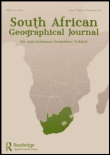
South African Geographical Journal
Pioneering scholarship in the heart of geographical sciences.The South African Geographical Journal, published by Routledge Journals, Taylor & Francis Ltd, is a leading scholarly platform dedicated to advancing research in the fields of geography, planning, and development. With an impressive history spanning from 1931 to 2024, this journal not only retains its relevance in the academic community but also proudly holds a Q2 rank in both Earth and Planetary Sciences and Geography, Planning and Development, marking it as a significant contributor to the scholarly discourse. The journal is ranked in the top 32% of its category within Scopus, affirming its stature among researchers and professionals. Although it currently does not offer Open Access, the journal provides a critical forum for the exchange of ideas, methodologies, and findings, encouraging dialogue that informs policy and practice in the geographical sciences. Readers can expect a rich variety of articles that encompass both theoretical and practical aspects of geography, making it essential for academics and practitioners alike.
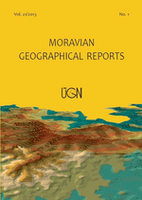
Moravian Geographical Reports
Empowering Researchers with Accessible Geographical StudiesWelcome to the Moravian Geographical Reports, an esteemed Open Access journal published by SCIENDO, dedicated to advancing the fields of Earth and Planetary Sciences as well as Geography, Planning and Development. Established in 1993, this journal has steadily built a reputation for disseminating high-quality research, evidenced by its 2023 Q2 ranking in both relevant categories and an impressive Scopus percentile ranking of 72. With a dedicated editorial board and an expanding global readership, the Moravian Geographical Reports serves as a vital platform for researchers, professionals, and students alike, fostering dialogue and collaboration across various dimensions of geographical and environmental studies. Since its shift to Open Access in 2013, it has significantly enhanced the accessibility and reach of its published works, making crucial research findings available to a broader audience. The journal continues to thrive as a significant contributor to the geographical and earth sciences discourse during its converged years from 1993 to 2024.

Boletin de la Asociacion de Geografos Espanoles
Advancing geographical insights for a sustainable future.Boletin de la Asociacion de Geografos Espanoles is a leading open-access journal dedicated to advancing knowledge in the fields of geography, urban studies, and environmental science. Published by the ASOCIACION ESPANOLES DE GEOGRAFIA, this esteemed journal has been a vital platform for geographers and researchers since 1984, facilitating the dissemination of high-quality research and insights. With an ISSN of 0212-9426 and E-ISSN of 2605-3322, the journal has been recognized for its contributions, currently ranking in Q3 in Earth-Surface Processes, Environmental Science, and Geography, Planning and Development, as well as Q2 in Urban Studies for 2023. The journal’s accessibility ensures a broad audience reach, supporting the engagement of researchers and professionals alike. Located in Madrid, Spain, and publishing from 2006 to 2024, the Boletin de la Asociacion de Geografos Espanoles stands as an essential resource for those invested in the geographical sciences and related disciplines.
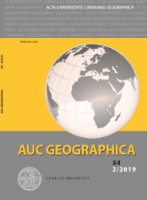
AUC Geographica
Championing Open Access to Geographic KnowledgeWelcome to AUC Geographica, a distinguished journal published by CHARLES UNIV PRAGUE, KAROLINUM PRESS, focusing on the expansive and interdisciplinary fields of Earth and Planetary Sciences, as well as Geography, Planning, and Development. With an ISSN of 0300-5402 and an E-ISSN of 2336-1980, this Open Access journal has been freely accessible since 2010, allowing researchers, professionals, and students to engage with high-quality scholarly articles without barriers. As of 2023, it holds a Q4 ranking in its respective categories, reflecting its commitment to contributing to the academic discourse despite competitive landscapes. Located in Prague, Czech Republic, at OVOCNY TRH 3/5, PRAGUE 1 116 36, AUC Geographica aims to foster collaboration and innovative research in the multifaceted relationships between human activities and the natural environment. With a publication history spanning from 1975 to 2024, this journal continues to be a vital resource for those seeking to advance knowledge and explore new dimensions in geography and Earth sciences.

Geographia Cassoviensis
Navigating the Frontiers of Geography and Earth SciencesGeographia Cassoviensis, published by the Pavol Jozef Šafárik University, Faculty of Science, Institute of Geography, is a pivotal platform for scholarly exploration in the fields of Earth and Planetary Sciences and Geography. Established in 2016, this journal has rapidly developed into a valuable resource for researchers and practitioners seeking to understand the intricate facets of geographical and environmental dynamics. With an ISSN of 1337-6748 and an E-ISSN of 2454-0005, Geographia Cassoviensis is indexed in Scopus and holds a position in the Q4 quartile for both its submission categories as of 2023, reflecting its burgeoning impact within the scientific community. Located in Kosice, Slovakia, this journal invites contributions that further the discourse in geography, planning, and related environmental studies. Although currently not an open-access journal, it aims to foster a deeper understanding of geographical concepts and their applications across diverse realms, making it a vital resource for students, researchers, and professionals alike.

EARTH is a prestigious journal published by MDPI, located in Switzerland, with a commitment to advancing the fields of Earth and Planetary Sciences and Environmental Science. Launched in 2020, the journal emphasizes an open-access publication model, ensuring that high-quality research is widely accessible to the scientific community and beyond. As of 2023, it proudly holds a Q2 ranking in both the Environmental Science and Earth and Planetary Sciences categories, indicating its significant impact within these disciplines; it ranks #90 out of 219 and #70 out of 159 in their respective fields according to Scopus. With the convergence of multidisciplinary research and the critical challenges our planet faces, EARTH seeks to publish innovative studies that foster a deeper understanding of geological and environmental processes. Researchers, professionals, and students alike will find this journal an invaluable resource for the latest findings and discussions shaping our understanding of Earth sciences.

Hrvatski Geografski Glasnik-Croatian Geographical Bulletin
Fostering Global Collaboration in Geographical ResearchHrvatski Geografski Glasnik-Croatian Geographical Bulletin, ISSN 1331-5854, E-ISSN 1848-6401, is an esteemed open-access journal published by the Croatian Geographical Society that has been serving the geography community since 1929. Based in Zagreb, Croatia, this journal focuses on a broad spectrum of geographical research, providing a platform for the dissemination of original articles, reviews, and case studies that contribute to the understanding of earth-surface processes and development planning. Although it currently holds Q4 rankings in both Earth-Surface Processes and Geography, Planning and Development, the journal is dedicated to enhancing its impact within the scientific community, aspiring to elevate research visibility and collaborative opportunities. With a commitment to open access, it ensures that all content is readily available to researchers, professionals, and students worldwide, fostering an inclusive environment for geographical scholarship. Engaging with this journal presents an opportunity to stay updated with emerging trends and pivotal studies within the discipline throughout its converged years from 1998 to 2024, making it a vital resource in geography and related fields.

Journal of Geographical Sciences
Unveiling Insights in Earth Sciences Since 2001.Welcome to the Journal of Geographical Sciences, a premier publication in the field of Earth and Planetary Sciences that has consistently demonstrated its impact and relevance since its inception in 2001. Published by SCIENCE PRESS, this esteemed journal is recognized for its rigorous peer-review process and high-quality research, achieving an impressive Q1 ranking in the 2023 category of Earth and Planetary Sciences (miscellaneous). With the latest Scopus ranking placing it at Rank #13 of 159, putting it in the top 8% of its field, the journal serves as a vital platform for disseminating significant findings and innovative methodologies in geography, environmental studies, and related disciplines. Although not an open-access journal, it offers exceptional visibility through its publication standards and accessibility in academic databases. Based in Beijing, China, the Journal of Geographical Sciences continues to pave the way for scholarly discourse and collaborative research, appealing to researchers, practitioners, and students dedicated to advancing our understanding of geographical phenomena.
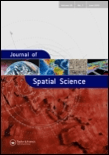
Journal of Spatial Science
Pioneering Research for a Sustainable Spatial FutureThe Journal of Spatial Science, published by Taylor & Francis Ltd, serves as a prominent platform for the dissemination of research in the interdisciplinary fields of geography, atmospheric science, and energy. With an ISSN of 1449-8596 and an E-ISSN of 1836-5655, this journal has established itself as a vital resource since its inception in 2004, boasting an impressive convergence period extending to 2024. Recognized in the Q3 quartile for Atmospheric Science and Energy (miscellaneous), and achieving a Q2 classification in Geography, Planning and Development in 2023, the journal not only reflects the evolving complexities of spatial science but also underscores its increasing relevance in addressing contemporary global challenges. The journal holds a commendable position in Scopus rankings, with notable placements in various categories, further highlighting its academic significance. Researchers, professionals, and students are encouraged to engage with the rich content offered, as the Journal of Spatial Science remains committed to advancing knowledge and fostering discussions pertinent to spatial analysis and its applications.
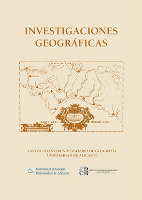
Investigaciones Geograficas-Spain
Innovating geographical discourse from Spain to the world.Investigaciones Geográficas-Spain is an esteemed academic journal published by the Universidad de Alicante, dedicated to advancing the fields of geography, planning, and development as well as earth and planetary sciences. With its commitment to open access since 1983, the journal ensures that research is readily available to a global audience, facilitating knowledge dissemination and collaborative discourse. As reflected in its 2023 Scopus rankings, it holds a commendable position within the Q3 category in both Earth and Planetary Sciences and Geography, Planning and Development, making it a noteworthy resource for scholars and practitioners in these disciplines. The journal's scope encompasses diverse geographical research, aiming to address pressing environmental and societal challenges through empirical studies and theoretical advancements. By contributing to the knowledge reservoir from Spain and beyond, Investigaciones Geográficas-Spain serves as a vital platform for researchers, professionals, and students seeking to enrich their understanding of geographical phenomena.